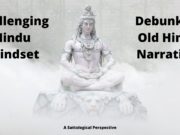Abstract
Sun Tzu’s The Art of War, written in 6th Century B.C., is popularly considered the most classic treatise on strategy of winning. The Bhagwad Geeta, a book from India dated 5000 years back, provides simple but profound Krishna-Arjuna Framework for winning.
This paper explains the Krishna-Arjuna framework for winning over equal competitors and discusses its relevance for global businesses.
The paper also highlights the acceptability of this framework by Indian businesses, as I gathered during my management development programs. Krishna-Arjuna framework suggests that winning over equal competitors quintessentially requires ‘right positioning (visioning) and focused action’. The Mind-Body Diagnostic Framework for building a winning organization (Sathe, Vijay and Smart, Geoffrey (1997) is quite close to Krishna-Arjuna Framework. This paper is divided into two parts. Part-I provides, introduction, literature review and the challenge of winning over equals. Part- II provides answer to the challenge of wining over equals as per Krishna- Arjuna Framework of Bhagwad Geeta.
Keywords: Winning, Competitiveness, Bhagwad Geeta, Krishna- Arjuna Framework
Introduction
The wars and the urge to win are innate to human beings and perhaps all living beings. The scarcity of opportunities and resources vis-a-vis the need (and greed) of the human beings have caused innumerable wars. The humanity has faced political wars, ideological wars, and social and other wars.
Businesses face their own wars. Business wars are essentially for money, markets, ideas, talent and technology.
With the opening- up of the borders by more and more nations, competition is getting truly global and intense. USA moved to number six from number one on the global competitiveness, as per The Global Competitiveness Report 2006-2007. The national competitiveness, as per World Economic Forum, is a function of the set of factors, policies and institutions that determine the level of productivity of a country. Raising productivity- meaning making better use of available factors and resources- is the driving force behind the rates of return on investment which, in turn, determine the aggregate growth rates of an economy. Thus, a more competitive economy will be one which will likely grow faster in a medium to long-term. “The top rankings of Switzerland and the Nordic countries show that good institutions and competent macroeconomic management, coupled with world-class educational attainment and a focus on technology and innovation, are a successful strategy for boosting competitiveness in an increasingly complex global economy”, said Augusto Lopez-Claros, Chief Economist; Director, Global Competitiveness Network (The Global Competitiveness Report, 2006-2007).
Literature Survey
Sun Tzu’s The Art of War, written in 6th Century B.C., has been considered as the most classic treatise on the strategy of winning. Winning has indeed turned much tougher in the newer environment because of newer mind-sets, mechanisms and technologies. No surprise, winning has attracted much research and publications in the last decade. Sathe, Vijay and Smart, Geoffrey (1997) found, “To ‘win’ in today’s highly competitive world, managers must continuously improve the mind and body of their organizations.
Diagnosis is the first step in any effort to create a winning organization. The mind-body framework is a practical tool for energizing such a diagnosis.
A strong ‘mind’, characterized by a high level of collective ambition, requires a clear sense of purpose and a high level of motivation. A strong ‘body’ provides the anatomy and physiology to enable the organization to achieve what the mind wills. Oliver, Richard W. (1998) listed seven strategic imperatives for winning in the new world of business. These included (i) Reinvent Yourself Daily, (ii) Make Your Customers Your Marketing Department, (iii) Create an Electronic Keiretsu, (iv) Personalize Everything, (v) Think Global/Act Global, (vi) Go Direct, and (vii) Replace Rules with Roles.
Ma, Hao (2003) found that a firm in an ongoing competition needs both sustainable advantage and temporal advantage.
It needs the luxury of ‘to win without fighting’ to secure the strengths and stability of its leadership position. It also needs to engage in, at least occasionally, selective fights using a confrontational strategy, so as to keep it sharp and be ready for major fights when necessary.
Caveats on the potential pitfalls notwithstanding, to win without fighting could indeed be a supreme strategy.
Stalk, George and Lachenauer, Rob (2004) found that the winners in business play hardball, and they don’t apologize for it. They listed five killer strategies for trouncing the competition. These included (i) devastate rival’s profit sanctuaries, (ii) plagiarize with pride, (iii) deceive the competition, (iv) unleash massive and overwhelming force, and (v) raise competitors’costs. Stalk, George (2006) identified curveball, as effective as hardball, strategy for vanquishing the competition. Curveball strategy essentially means fooling the competitors.
The four types of curveball strategies include draw your rival out of the profit zone by luring competitors into less profitable business, employ unfamiliar techniques, disguise your success and let rivals misinterpret your success.
Jack Welch (Welch Jack with Suzy Welch, 2005) wrote that ‘probably no other topic could have made me want to write again (after his autobiography)…winning is great. Not good- great‟.
Challenge of Winning over Equals
Winning is really the most loved, admired, valued and exciting in human life. Winning and success are the two most coveted words in all battles of life, including business. The media and publications have recently been replete with stories about battles for Number One like ‘Why Starbucks is Number One in Business’, ‘Nokia’s battle to stay world’s number one’ and ‘Why Toyota Is Afraid of Being Number One’. ‘Be No. 1 or No. 2 in every market, and fix, sell, or close to get there’, initiative of GE, after Jack Welch became CEO in 1981, has been much publicized and a well- known mantra to win. Aditya Birla Group of India did the similar after Kumar Mangalam Birla took over as Chairman in the mid-nineties.
The real challenge these organizations have faced is how to win over equals; as the battle for number one is always between equals.
During 80s, competitiveness was identified as the prime winning strategy of business (Michael Porter, 1980, 1985, 1990). The Rule of Three (Sheth and Sisosdia, 2002), (or Four in Europe, or even Two in soft drinks in USA), however, would demand winning over equals as the prime strategy of business in 21st Century. The competition is certainly going to intensify. We may take an example of the world automotive manufacturers. There were 57 independent automotive manufacturers in 1970, in 2005 the figure came to 13, and it is expected that by 2015 there will be only 6-8 automobile companies. The truth of the matter of competitiveness is that businesses compete; nations compete; and people compete; one-to-one, at a time. Indeed, ‘One at a time’ has always been the fastest way to do things. Lakshmi Mittal, the steel tycoon, is the most recent and the best example of the same. All cultures, since time immemorial, have also portrayed battles between the two, often labeled as the battle between the good and the evil. Indeed, the Numero Uno signifies continuing battle of one over the other.
A saying goes that the best way to become number one is to kill (or merge or acquire) the number one. In a fiercely competitive world, the question gains added importance.
–
Sat Parashar, PhD
[The author is former Director, IIM Indore. He is currently Adjunct Faculty, teaching Money and Banking at the Rady School of Management, University of California, San Diego. He is also practicing Financial Advisor and the Hotel Investment Advisor.
Disclaimer : the views expressed are personal to the author
pls donate to help our services:
Note: This article was originally published in International Journal of Indian Culture and Business Management 2008 – Vol. 1, No.3, pp. 354 – 359. For complete references, may please see original.















